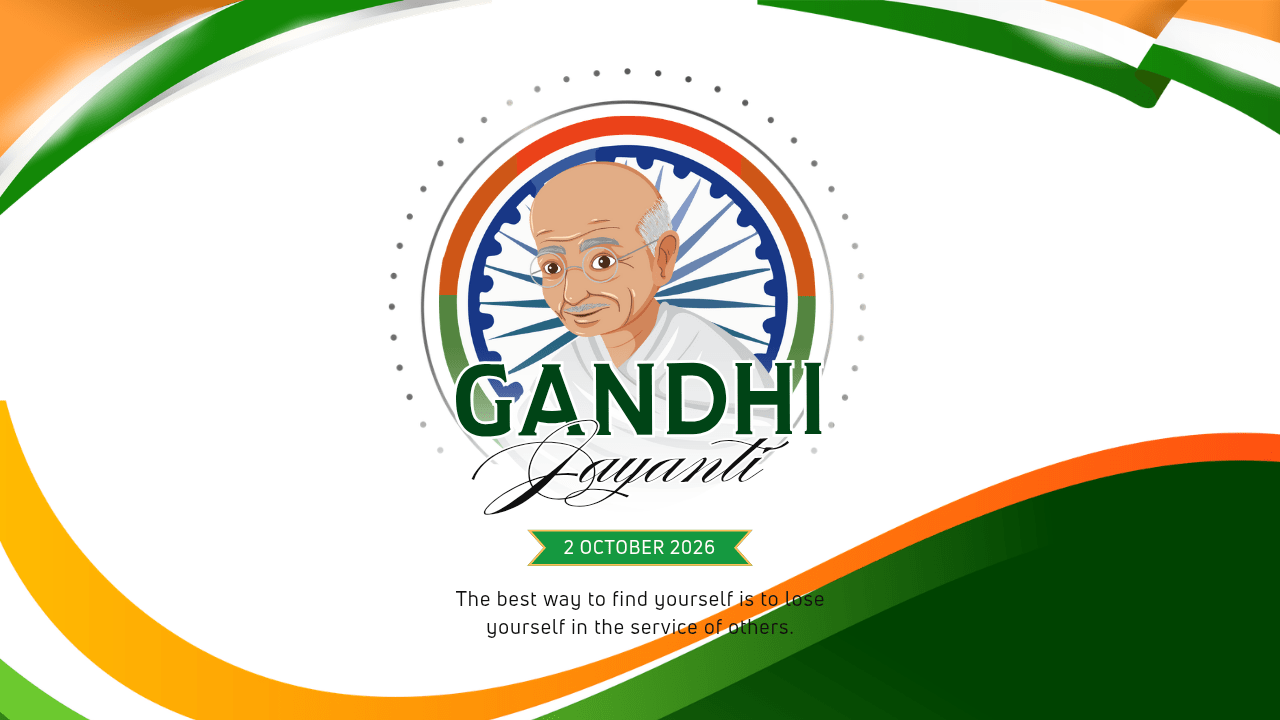The 2nd of October is etched forever in the global calendar as the birth anniversary of Mohandas Karamchand Gandhi, revered worldwide as Mahatma, or ‘Great Soul.’ This annual commemoration, universally known as Gandhi Jayanti, is far more than just a national holiday in India. It is a moment of profound global reflection on the principles of peace, truth, and non-violent resistance (Ahimsa and Satyagraha) that changed the course of history.
As we approach Gandhi Jayanti 2025, it’s crucial to look beyond the customary ceremonies and delve into the practical relevance of his teachings in our complex modern world. He wasn’t just a political leader; he was a social reformer, a profound moral philosopher, and an individual who demonstrated the colossal power of an indomitable will driven by truth.

His life continues to be a living message, guiding activists, leaders, and everyday citizens toward a more just and sustainable future.
The Man, The Movement, The Message
Born in Porbandar, Gujarat, in 1869, Mahatma Gandhi’s journey from a young lawyer in South Africa to the Father of the Nation of India is a testament to the transformative power of principle. His life’s work revolved around the core philosophy of Satyagraha, which literally translates to ‘truth force’ or ‘soul force’—a method of non-violent resistance that seeks to convert the opponent through patience and compassion, rather than coercion.
A. The Pillars of Gandhian Philosophy
Gandhi’s vision for a free India, and indeed a better world, was built upon four foundational pillars:
- Ahimsa (Non-Violence): This was Gandhi’s supreme tenet. It was not merely the absence of violence, but an active, positive force of universal love and self-suffering.
- Satya (Truth): For Gandhi, Truth was God, and the pursuit of truth was the highest form of worship. Satyagraha is, fundamentally, holding fast to truth.
- Sarvodaya (Welfare of All): Inspired by John Ruskin’s Unto This Last, this principle advocates for the welfare and upliftment of all people, emphasizing the need to serve the most marginalized sections of society.
- Swadeshi (Self-Reliance): The movement to promote domestically produced goods, most famously symbolized by the Khadi hand-spun cloth, was an economic strategy to boycott foreign goods and empower local artisans and villages.
B. Why 2nd October Holds Global Weight

The universal resonance of Gandhi’s work led the United Nations General Assembly to declare October 2nd as the International Day of Non-Violence in 2007. This official recognition underscores that Gandhi’s methods are not just historical artifacts but practical tools for conflict resolution and promoting peace in the 21st century.
Gandhi’s Principles in the Modern Era
While Gandhi led a movement in the early-to-mid 20th century, his ideas are surprisingly relevant to our current global crises, from climate change to social inequality.
Also Read: Remembering Shaheed-e-Azam: Bhagat Singh Birth Anniversary
Gandhi Jayanti 2025 Inspirational Quotes
- “Be the change that you wish to see in the world.” – Gandhi
- “The best way to find yourself is to lose yourself in the service of others.” – Gandhi
- “An eye for an eye will make the whole world blind.” – Gandhi
- “Happiness is when what you think, what you say, and what you do are in harmony.” – Gandhi
- “Strength does not come from physical capacity. It comes from an indomitable will.” – Gandhi
- “Live as if you were to die tomorrow. Learn as if you were to live forever.” – Gandhi
- “In a gentle way, you can shake the world.” – Gandhi
- “The future depends on what you do today.” – Gandhi
- “You must be the change you wish to see in the world.” – Gandhi
- “Hate the sin, love the sinner.” – Gandhi
Non-Violence and Digital Citizenship
In the age of social media, where polarization and online aggression are rampant, the concept of Ahimsa takes on a digital dimension. A true follower of Gandhi must practice Digital Satyagraha, abstaining from hate speech, misinformation, and online bullying.
- Practicing Digital Ahimsa: Before you share or comment, ask yourself if the action promotes truth and love, or anger and divisiveness.
- Embracing Dialogue: Seek to understand opposing views and engage in respectful debate, prioritizing consensus over conquest.
The Economic Principle of Trusteeship
Gandhi advocated for the principle of Trusteeship, suggesting that the wealthy should hold their surplus assets as a trust for the welfare of the entire society. This radical idea predates and complements modern concepts of Corporate Social Responsibility (CSR) and ethical wealth distribution.
- Real-World Impact: An increasing number of philanthropic movements and impact investing firms today reflect this trusteeship model, aiming to use capital to solve societal problems rather than solely for private accumulation. This philosophical shift is vital in narrowing the global wealth gap. According to Oxfam (2024), the world’s five richest men have more than doubled their wealth since 2020, highlighting the urgent need for a more equitable “Sarvodaya” approach to wealth.
Swachh Bharat and Cleanliness
Gandhi famously stated, “Sanitation is more important than political independence.” This focus on internal and external cleanliness became the inspiration for the Indian Government’s flagship program, the Swachh Bharat Abhiyan (Clean India Mission), launched on Gandhi Jayanti in 2014.
This campaign is a direct, actionable example of how a Gandhian ideal can be translated into a massive public movement for health and dignity.
Celebrating Gandhi Jayanti 2025: From Reflection to Action

How can we truly honor Bapu’s legacy this year? The best tribute is not a mere recitation of quotes, but a commitment to action.
Action Points for a Meaningful Gandhi Jayanti:
- Volunteerism and Service: Dedicate a few hours to community service, embodying the principle of Sarvodaya. This could be cleaning a local park, donating time to a shelter, or teaching a skill.
- Practice Khadi and Local Consumption: Support local artisans and industries. By choosing Swadeshi goods, you contribute to a more self-reliant and decentralized economy, echoing Gandhi’s focus on village self-sufficiency.
- Study His Writings: Take time to read his works like My Experiments with Truth to gain a deeper, firsthand understanding of his moral journey.
- Promote Peace: Participate in local peace rallies, interfaith dialogues, or simply resolve a long-standing personal conflict through non-violent means.
Be the Change on Gandhi Jayanti
Mohandas Karamchand Gandhi once famously advised, “You must be the change you wish to see in the world.” This powerful, concise command is the ultimate takeaway of Gandhi Jayanti 2025. It’s a call for personal transformation as the prerequisite for social change. We don’t need to lead nations to practice his ideals; we simply need to commit to truth, simplicity, and non-violence in our daily lives.
This October 2nd, let’s pledge to move beyond passive remembrance and become an active force for good. Let his legacy inspire us to solve our problems—be they personal, local, or global—with moral courage and the invincible power of peace.
FAQs on Gandhi Jayanti 2025
Q1: Is Gandhi Jayanti a public holiday in India?
A: Yes, Gandhi Jayanti is one of the three national holidays in India, observed across all states and union territories. The other two are Republic Day (January 26) and Independence Day (August 15).
Q2: What is the significance of the International Day of Non-Violence being observed on October 2nd?
A: The United Nations declared October 2nd as the International Day of Non-Violence in 2007. This is to globally acknowledge Mahatma Gandhi’s philosophy of Ahimsa (non-violence) as a universal principle for building a culture of peace, tolerance, and understanding.
Q3: What is the meaning of the title ‘Mahatma’?
A: The Sanskrit word ‘Mahatma’ means ‘Great Soul.’ It is widely believed to have been bestowed upon Mohandas Karamchand Gandhi by the Nobel Laureate and poet Rabindranath Tagore, recognizing his extraordinary moral and spiritual stature.
Q4: How is Gandhi Jayanti typically celebrated across India?
A: The day is marked by prayer meetings, particularly at Raj Ghat in New Delhi (Gandhi’s memorial), where political leaders and citizens pay tribute. Schools and colleges hold cultural programs, essay competitions, and functions promoting Gandhi’s teachings, and the day often involves activities promoting cleanliness (Swachh Bharat).
Q5: What is Satyagraha, and why is it central to Gandhi’s legacy?
A: Satyagraha is Gandhi’s unique method of non-violent resistance. It combines two Sanskrit words: Satya (Truth) and Agraha (Insistence or holding fast). It is a form of political action that involves non-cooperation and peaceful civil disobedience, aiming to achieve change by appealing to the conscience of the oppressor rather than inflicting suffering.
















